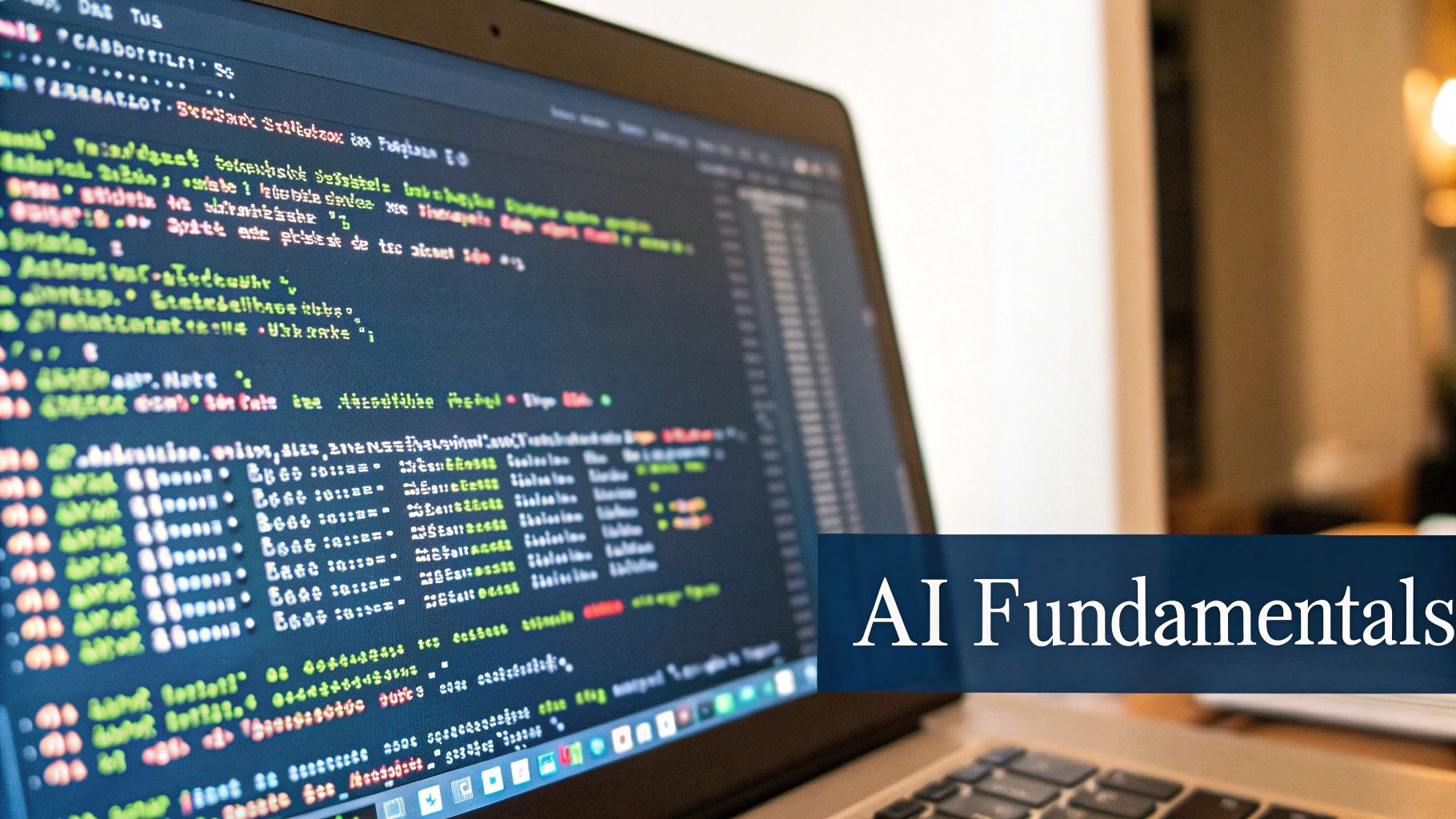How to Learn Artificial Intelligence: Your Step-by-Step Guide to Mastering AI
"Understanding the Evolution of Artificial Intelligence" in a more natural, blog-style:
Understanding the Evolution of Artificial Intelligence
Learning AI isn't just about mastering the latest tools and techniques. Having a solid grasp of how artificial intelligence has developed over time gives you valuable context that helps guide your learning journey. When you understand the key developments and breakthroughs that shaped AI, you can make better choices about what to focus on and which resources to use.
Early Days and the Turing Test
The story of artificial intelligence began relatively recently, in the mid-20th century. A defining moment came in 1950 when Alan Turing published his paper "Computer Machinery and Intelligence," introducing what became known as the Turing Test. This test, which evaluates whether a computer can convincingly mimic human conversation, sparked intense interest in machine intelligence. In 1955, John McCarthy coined the term "artificial intelligence," officially establishing AI as its own field of study. For more background on AI's early history, check out these detailed statistics and milestones.
The Rise of Expert Systems
The early enthusiasm around AI led to some major advances, but also periods where progress slowed considerably. During the 1980s, researchers developed expert systems – programs designed to solve complex problems by mimicking human expertise in specific areas. While these systems had limited scope, they proved that AI could tackle real-world challenges in fields like medicine and finance. This success attracted substantial research funding that helped move the field forward.
The Neural Network Renaissance and Modern AI
After a period of reduced interest and funding (dubbed the "AI winter"), the field found new life through advances in neural networks. Two key factors drove this revival: massive increases in computing power and access to large amounts of data for training AI systems. This resurgence set the stage for today's AI landscape, dominated by deep learning, machine learning, and renewed efforts to achieve artificial general intelligence (AGI) – AI systems that can match human-level thinking across many tasks.
The Future of AI and Your Learning Journey
The pace of AI development shows no signs of slowing down. New breakthroughs emerge regularly, creating both exciting possibilities and complex challenges for those studying AI. By understanding how the field has evolved, you'll be better equipped to learn effectively, spot emerging trends, and contribute meaningfully to AI's ongoing development. This historical perspective helps you build a strong foundation while staying focused on where AI is headed next.
Choosing Your AI Learning Tools and Resources
Learning AI can feel like a maze given all the options available. But there's no need to get stuck – the key is finding the right mix of tools that match how you learn best. Let's explore how to build a learning plan that works for you.
Identifying Your Learning Style and Goals
Everyone learns differently – some prefer structured classes, others learn best by doing projects, and many thrive in group settings. Start by reflecting on how you learn most effectively. Be clear about what you want to achieve too. Are you switching careers? Adding new skills? Just exploring AI out of interest? Your answers will guide which learning tools make the most sense.
Exploring Different Learning Platforms
Each type of learning platform offers unique benefits. Massive Open Online Courses (MOOCs) provide organized lessons complete with videos, quizzes and assignments. Interactive coding platforms let you learn through hands-on practice and projects. Online communities and forums connect you with other learners for support and discussion. Using several platforms together often leads to better understanding.
Evaluating Platform Effectiveness and ROI
When choosing platforms, look at key factors like the reputation of the platform, instructor expertise, and how well the content matches your needs. Read reviews from past students and check if the platform has proven results. Consider both time and money – what will you invest and what skills will you gain? This ties into broader trends in AI education. For instance, while 86% of students now use AI tools, 58% feel they need more AI knowledge according to a recent survey. Choosing effective learning resources is crucial.
Building Your Personalized Learning Stack
Create a personalized learning stack by combining different tools that work for you. You might begin with a MOOC for core concepts, then practice on coding platforms to build real skills. Add books, articles and community discussions to round out your knowledge. The most successful learners often mix different approaches to get the full picture.
Learning From Breakthrough AI Implementations
Success in AI comes from both study and real-world experience. By examining actual AI projects – both wins and failures – you can gain practical insights that textbooks alone can't provide. Let's explore what we can learn from these real implementations.
Identifying Key Principles From Successful AI Projects
The most effective AI initiatives share some common elements. They begin with crystal-clear goals and a solid grasp of available data. For example, when AI teams focus on specific measurable objectives like improving medical diagnoses or making supply chains more efficient, they can build targeted solutions and track real results. These successful projects also emphasize ongoing testing and refinement as new information comes in.
Lessons Learned From AI Failures
Understanding what went wrong in failed AI projects is just as valuable as studying successes. Common issues include poor data quality, fuzzy objectives, or choosing the wrong AI approach for the problem. Take biased training data – it often leads to biased AI outputs, showing just how critical good data is. Looking back at AI's history provides perspective here. The 1980s saw major progress with expert systems that copied human decision-making in specific fields. One notable success was the R1 system that saved Digital Equipment Corporation $40 million per year by 1986. Learn more about these historical developments in AI's evolution and impact.
Applying Insights to Your AI Learning Journey
When you study successful AI implementations, you get a practical roadmap for your own learning path. By seeing what skills top AI teams rely on, you can spot gaps in your own knowledge – whether that's specific programming languages, frameworks for deep learning, or methods for analyzing data.
Developing Critical Thinking Skills for AI Success
Technical skills matter, but sharp critical thinking is essential for navigating AI's complexities. This means questioning assumptions, weighing evidence carefully, and considering the ethics of AI systems. For instance, understanding how bias can sneak into datasets helps create more fair and effective AI solutions. As AI keeps growing, this ability to think critically about its effects becomes more and more important.
the section in natural, human-written style while preserving key information and formatting:
Navigating AI Career Opportunities and Market Trends
Starting a career in AI is an exciting journey filled with possibilities. Let's explore how to turn your AI skills into a rewarding profession and make smart choices for your career path.
Identifying High-Growth AI Specializations
The AI field offers many promising career paths. Focusing on a specific area can help you stand out and build deeper expertise. Some of the fastest-growing specializations include:
- Machine learning engineering roles at companies using data-driven decision making
- Deep learning positions in research and development
- Natural language processing (NLP) jobs building chatbots and language tools
- Computer vision roles in autonomous vehicles, security, and medical imaging
Aligning Your Skills with Market Demand
Success in AI requires more than just technical knowledge. While programming and math skills are essential, employers also highly value soft skills like:
- Clear communication of complex concepts
- Creative problem-solving abilities
- Effective collaboration in teams
- Adaptability to new tools and techniques
Keeping up with emerging AI technologies and industry trends will also make you stand out to potential employers.
Building a Standout Portfolio and Navigating the Interview Process
Your portfolio is crucial for demonstrating real-world AI skills. Include meaningful projects like:
- Personal experiments and applications
- Contributions to open-source AI projects
- Results from Kaggle competitions
Strong interview performance is equally important. Practice explaining your work clearly, walking through your problem-solving approach, and showing deep understanding of AI fundamentals.
Career Advancement and Salary Negotiation in AI
The AI field offers excellent growth potential. With experience, you can advance to senior positions like AI Architect or Head of AI. The strong job market gives you leverage in salary discussions – research industry standards and be ready to highlight your unique value.
This growth extends across industries, particularly in education where AI is making major impacts. In fact, experts project the global AI in education market will reach $88.2 billion by 2032. Learn more about AI's educational impact in these detailed industry statistics.
Creating Your Personalized AI Learning Roadmap
Learning AI effectively requires careful planning and a clear sense of direction. A well-designed roadmap helps you focus your efforts, track progress, and maintain momentum as you build your AI knowledge and skills.
Defining Your AI Learning Objectives
Begin by getting specific about what you want to achieve. Consider whether you're looking to switch careers into AI, incorporate AI tools into your current role, or simply learn more about this field out of interest. Your goals directly shape what and how you'll need to learn. For instance, aspiring machine learning engineers need deep technical skills, while marketers may focus more on applying AI tools to analyze customer data.
Assessing Your Current Skills and Knowledge
Take an honest look at where you're starting from. Review your experience with key programming languages like Python, and assess your grasp of essential math concepts like statistics and linear algebra. Understanding your current skill level helps you choose appropriate learning materials and set realistic goals that build on your existing knowledge.
Selecting Learning Resources and Building Your Curriculum
AI learning resources come in many forms, each serving different needs. Online courses provide structured lessons and hands-on practice. Technical books offer deep dives into theory and concepts. Interactive coding platforms let you experiment with real code. AI communities connect you with other learners for support and knowledge sharing.
The best approach often combines multiple resources. Start with fundamentational concepts through structured courses, then practice by building projects. Join learning communities to get feedback and stay current with new developments in the field.
Structuring Your Learning Plan and Setting Milestones
Break down your learning journey into concrete, achievable steps. Create a schedule that fits your life and set clear goals – like finishing specific course modules weekly or completing practice projects monthly. For example, you might aim to complete an introductory machine learning course in three months, then build a simple AI project using real data.
Staying Motivated and Overcoming Challenges
Learning AI takes time and persistence. When you hit roadblocks or feel stuck, having support systems in place makes a big difference. Connect with other learners through study groups or online forums where you can share challenges and learn from others' experiences. Remember to celebrate small wins along the way, and focus on steady progress rather than rushing through concepts.
With a thoughtfully designed roadmap and consistent effort, you can build strong AI skills aligned with your goals. Stay flexible and adjust your approach based on what works best for you. Whether you're aiming for an AI career or expanding your technical toolkit, a clear learning plan sets you up for success.
Building Your AI Project Portfolio
A strong portfolio is crucial for aspiring AI professionals to bridge classroom learning with job-ready skills. Think of it as your highlight reel – a way to show employers that you can turn theory into working solutions.
Choosing the Right AI Projects
The best AI portfolio projects demonstrate both technical ability and business value. Start with projects that excite you and match your career interests.
- Focus on Real Problems: Look for actual challenges you can solve, even simple ones. A weather prediction model or social media sentiment analyzer shows you can apply AI to practical needs.
- Show Different Skills: Include 2-3 projects using varied techniques like machine learning, natural language processing, and computer vision. This proves you understand AI's many applications.
- Align with Career Goals: If you want to be a machine learning engineer, highlight model building and coding. For AI research roles, focus on testing novel algorithms and approaches.
Managing Project Implementation
Even basic AI projects need careful planning. Here's how to stay organized and deliver quality work:
- Start Small: Begin with clear, limited scope to avoid getting stuck. As you gain confidence, tackle bigger challenges. Each project teaches lessons you can apply to the next.
- Use Version Control: GitHub helps track code changes and enables collaboration. You can roll back mistakes and manage different project phases easily.
- Document Everything: Keep detailed notes on your design choices, data sources, problems faced, and solutions found. Good documentation shows employers your problem-solving process.
Presenting and Documenting Your AI Work
How you present your work matters as much as the work itself. Clear communication shows you can explain complex ideas to different audiences.
| Feature | Description |
|---|---|
| Project Overview | Clear summary of goals, methods used, and key findings |
| Technical Details | Walkthrough of AI techniques, data prep, model selection, and implementation |
| Results & Analysis | Visual presentation of insights and performance metrics |
| Code & Documentation | Accessible project files and documentation on GitHub |
Taking time to document thoroughly helps cement your own learning while creating an impressive portfolio that gets noticed.
Ready to take your website to the next level? Check out DebugBar, the essential tool for web developers, designers, and marketers. It helps you optimize performance, diagnose issues, and improve your development process. Visit DebugBar today!



